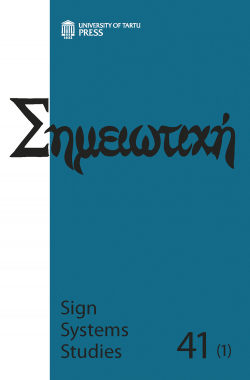Cassirer, Benveniste, and Peirce on deictics and "pronominal" communication
DOI:
https://doi.org/10.12697/SSS.2013.41.1.01Keywords:
Benveniste, Cassirer, deixis, Jakobson, Peirce, post-structuralism, pronoun, structuralismAbstract
For all his profound interest in Secondness and its manifestation in various kinds of indices, including deictics, Peirce rarely addresses the inter-pronominal relationships. Whilst the American founder of semiotics would designate languageas a whole to Thirdness, only within the larger framework of which deictics can work, the German philosopher Cassirer observes that "what characterizes the very first spatial terms that we find in language is their embracing of a definite 'deictic' function". For Cassirer the significance of pronominals, especially the I-Thou relationship, lies in its impact on the development of spatial concept that lays the foundation of symbolic forms. It may look strange why the "designatives" of I, Thou, He, in Peirce's own terms, so obvious in their categorial and empirical differentiation, should fail to be reduceable to the triad of Firstness, Secondness, and Thirdness. It is interesting, however, that in his 1906 correspondence with Lady Welby, Peirce should refer to the strange "Communicational Interpretant", or "the Cominterpretant, which is a determination of that mind into which the minds of utterer and interpreter have to be fused in order that any communication should take place". Peirce asserts that this communication of a Form, say, being in love, is made possible by sign. This paper discusses Peirce's and Cassirer's references to deictics or indexical sign, in particular, inter-personal relationships, in light of Benveniste's concept of discourse, and probes into a possible subtext underlying the Peirce-Welby correspondence.Downloads
Download data is not yet available.
Downloads
Published
2013-05-17
How to Cite
Chang, H.- liang. (2013). Cassirer, Benveniste, and Peirce on deictics and "pronominal" communication. Sign Systems Studies, 41(1), 7–20. https://doi.org/10.12697/SSS.2013.41.1.01
Issue
Section
Articles


